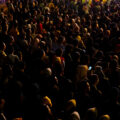Technology as a religious agent
Technology as a religious agent
Having meals via Zoom? Celebrating religious services in front of a camera? Tuning in on Mass from your own sofa? What might have been unthinkable a couple of months ago, has now become reality. Since the moment large gatherings were no longer allowed due to coronavirus, technology has become the tool for humans to communicate. Not only in everyday life, but also in religion.
This article was written in preparation for our round table on digital religion. Please find the full white paper here.
Since March 2020, Europe is in the grasp of COVID-19, the new coronavirus. Many European governments cancelled all large gatherings to limit the spread of the virus. As a result, religious gatherings and events could no longer take place. However, as illustrated in the examples above, faithful are looking for new ways to participate in social events and connect with one another. This has led to the strengthening of technology as a key religious agent. Even though technology was present in the religious lives of faithful to some extent before coronavirus emerged, research from Belarus points out that the coronavirus crisis has accelerated digitalisation by at least ten times.[1] The rising influence of technology in religion is clearly illustrated by the many initiatives of churches, synagogues, and mosques to be together in a digital way. Although some religious groups already made wide use of technology, for most it is a new way of reaching out to their community. Taking religious gatherings online has caused the digitalisation of religion, which started before COVID-19, to be particularly visible today. This article will first consider the traditional religious agents present in Europe. Then, the influence of technology as a new religious agent – in the context of COVID-19 – will be discussed. The benefits and drawbacks of this new religious agent will also be considered.
Religious agents as we know them
Before COVID-19, several European actors were particularly important religious agents. For instance, the pope in Vatican City, orthodox bishops in Eastern Europe, and the Church of England in the United Kingdom come to mind. Pope Francis’ messages reach large parts of the world. In the past, he has called attention to vulnerable groups,[2] religious freedom,[3] and climate change.[4] Religious buildings may be viewed as religious agents as well, in the sense that they play an important part in the lives of faithful. Before coronavirus emerged, faithful would regularly gather in churches, mosques, or synagogues. Getting together for a religious celebration, singing and praying together, and being quiet together are all very important aspects of any faith. Even speaking to each other after the service is often considered as a crucial part of living faith.[5] Besides traditional leaders and institutions, some politicians are also heavily involved in the religious traditions of their country. This is particularly seen in many Eastern European countries. To illustrate, Aleksandr Lukashenko, the president of Belarus, recently stated that “Orthodox Christianity traditions remain the moral foundation for Belarusian people.”[6]
Digital literates springing up like mushrooms
As a result of coronavirus, many religious traditions have to be adapted in order to limit the spread of the virus. Therefore, most religions have increased their use of digital technologies to reach faithful and connect with them. However, technology is not entirely new in the religious world. For example, evangelical and charismatic churches in the Netherlands have been particularly active online for the past few years. They have found that social media are an easy way to reach faithful and to keep them updated.[7] Due to coronavirus, however, more and more religious institutions and figures have implemented or increased the use of technology. For instance, Pope Francis has been live streaming his morning services from Vatican City, and spoke in front of an empty St Peter’s Square, rather than asking faithful to come to his services.[8] In Germany, pastoral care via telephone has gotten much more attention, as pastors cannot visit church members.[9]
An especially interesting development regarding the use of technology is the celebration of religious holidays in various religions. Easter, Ramadan, and Passover all took place during the coronavirus crisis. Even though these holidays are usually celebrated with friends and family, religious communities quickly shifted to the use of technologies. For instance, Jewish communities adapted the rules for using technology during the Seder meal. For most Jews, the use of virtual methods of communication was allowed, as long as the session was set up before the actual meal began.[10] Moreover, where Easter is usually celebrated in a church building, churches now live streamed their services. In Germany, a pastor found that placing photos of the members of his congregation on his church benches helped him to imagine that he indeed was conducting a service for the whole congregation.[11] Muslims have also adapted their celebrations of Ramadan. Rather than gathering with family and friends, for instance, faithful get in touch via digital communication platforms such as Skype.[12]
Connecting with a greater audience
Now that we have seen how faithful digitalise their religion during COVID-19, it is time to discuss the benefits and drawbacks of technology as a new religious agent. Religious communities around Europe are experiencing three main benefits: connection, reach, and bridging gaps.
First of all, digital technologies allow faithful to remain connected with their community, even though physical gatherings are cancelled. By gathering online or watching a live-streamed service, one can still have a sense of community. Even in times of quarantine, this contributes to feelings of collectivity. In fact, according to The Guardian, some faithful are connecting more often than ever during times of coronavirus.[13] Moreover, Danish newspaper Berlingske writes that believers are becoming even more religious than they were before.[14] Not only services and celebrations are taken online; other parts of the religious lives of faithful are also continuing digitally. In the Netherlands, for example, young catechumen are discussing their topics via WhatsApp chats and calls.[15] In Scotland, coronavirus could not stop the induction of a new priest – not in real life, but via Zoom.[16]
Second, technology enables religious communities to reach greater audiences than ever before. It is easier to join the celebrations of a certain church, mosque, or synagogue, even if they are located in another region or country. Therefore, several religious institutions are experiencing an increase in their geographic scope. For instance, a church in Oulu, northern Finland, found that its live streams reach more people in Helsinki than in Oulu itself.[17] Similar developments are seen in the United Kingdom, where one in four British adults have joined a religious service since coronavirus lockdowns began, compared to six percent of adults who regularly attend services during normal times.[18] This is illustrated by the Anglican Palm Sunday mass at Plymouth Cathedral. The church, which usually draws 650 worshippers, had 2,200 people tune into the online service.[19] Also in Ireland, a huge peak is seen in the number of people that are connecting to online services, in comparison to the number of people that physically came to church before COVID-19.[20] [21] Moreover, the pope even reached as much as 11 million people whilst giving the special blessing Urbi et Orbi on Friday the 27th of March – a blessing that is normally only given on Christmas Day and Easter Sunday.[22] Not only can technologies help to increase religions’ geographic scope; they can also help to reach new groups. For instance, mosques are able to reach young people, who are increasingly difficult to get in touch with, through the use of digital platforms.[23]
Finally, news reporters find that digital technologies allow for bridging the gap between religious people that have not gone to church for a longer period of time on the one hand, and churches that now live stream their services on the other. For example, BR24 reports that in Germany, many who have left the church use technology to share the message of Christ through podcasts, blogs, and social media.[24] Because the current crisis forces traditional communities to think about ways to go online, it is an opportunity for traditional churches and people who have left the church – but not their faith – to find each other again.
Technology cannot replace gatherings
Despite the many benefits of technology as a new religious agent, two key drawbacks can be identified: the inability to replace live gatherings and an individualistic approach to religion.
First, articles from several countries report that virtual services cannot fully replace the usual gatherings.[25] [26] In Germany, Thomas Sternberg, President of the Central Committee of German Catholics, stated that the most important aspect of faith is celebrating the Eucharist. As this is a communal activity, Sternberg argues that this cannot be replaced by a digital service.[27] Other aspects of live gatherings, such as singing or praying together, are also experienced to be harder when meeting online. Pope Francis has also expressed his thoughts on the online community, claiming that faith cannot be lived only digitally. In addition, Erik Borgman, a Dutch professor in public theology, argued that the liturgy has become the most central part of online services, whereas the community – a crucial aspect of faith – has become less important. One has to be careful that the sense of community does not have to suffer under this crisis, Borgman argues.[28] In Greece, the missed traditions around orthodox Easter are seen as a great loss. Whereas these are usually celebrated with friends, family, and strangers, coronavirus has made this impossible.[29]
Second, some faithful fear for a more individualistic approach towards religion as a result of digitalisation. For instance, Italians have been allowed to tell their sins directly to God, without a priest’s involvement.[30] Moreover, several groups may not be able to attend religious services, such as the elderly and those without access to the required technology or devices.[31] This may lead to increasing gaps between groups and individuals. Ed Kilgore, columnist for New York Magazine, also argues that digitalisation may lead to individualistic religion. He writes that organised religion is tested during this time of coronavirus, which might lead people to take a step back from the rituals performed in religious celebrations. Taking this step back could cause a more individualistic interpretation of faith, according to Kilgore.[32] Also Catholic scholar Franco Cardini states that individualistic faith prevails, as praying by oneself or praying together cannot be compared.[33] Finally, even groups that connect through social media platforms may feel like they are living their religion individually. For instance, podcast producer Hanna Kunze has stated that she would prefer a streamed sermon over posting a comment on Facebook.[34]
Different points of view
Technology is a new religious agent in the lives of faithful. The emergence of this agent has been accelerated in the past few months, due to the emergence of COVID-19. Digital technologies allow religious institutions and figures to reach greater audiences and to connect with one another. Nevertheless, many faithful miss live gatherings and argue that online services cannot replace live gatherings. Moreover, being involved in religious activities from one’s own home might lead to a more individualistic approach to religion. Thus, the benefits and drawbacks of technology as a religious agent can result in many different points of view. What is your opinion on technology as a religious agent? And how can these developments be seen in your country or religious group?
Would you like to stay updated on religion and society? Visit the EARS Dashboard.
[1] Pandemic accelerated digitalization 10 times
[2] Paus vraagt steun voor migranten in kersttoespraak
[3] Papa: “Mi fanno paura i discorsi di alcuni leader populisti, seminavano odio già negli anni Trenta del secolo scorso”
[4] Papa Francesco e l’allarme inascoltato sul clima, finora troppe parole e pochi fatti
[5] De kerk is leeg, de gelovige zit thuis: wat nu?
[6] Lukashenko: Orthodox Christianity traditions remain moral foundation for Belarusian people
[7] De kerk is leeg, de gelovige zit thuis: wat nu?
[8] Papa a piedi in centro a Roma va a venerare il crocifisso miracoloso che fermò la peste nel 1522
[9] Psychische Probleme in Corona-Krise Telefonseelsorge am Anschlag
[10] Israel prepares for a Seder night different from all other Seder nights
[11] Trotz Corona volle Bänke in Bopparder Kirche
[12] UK Muslims prepare to take Ramadan online | World news
[13] Coronavirus: How do you celebrate a religious festival while social distancing?
[14] Coronavirussen gør de troende mere religiøse – og fanatikerne dødsensfarlige
[15] Belijdeniscatechisatie volgen via WhatsApp – Kerk & religie
[16] New church minister inducted online due to Covid-19 restrictions
[17] Netissä näkyy nyt naurava kirkko – Sunnuntai | HS.fi
[18] Coronavirus: Churches may not be back to normal by end of year
[19] UK churches to livestream Easter services during lockdown
[20] Over 1.5m view religious service from Knock online
[21] Surge in people viewing church services online
[22] Pope’s blessing in empty St Peter’s Square watched by 11m on TV
[23] UK Muslims prepare to take Ramadan online | World news
[24] Glaube ja, Kirche nein: Frömmigkeit findet im Internet Zulauf
[25] Kirche und Glaube in Coronazeiten – Der Gottesdienst “fehlt schon sehr”
[26] Voxpop: Hvordan fejrer jødiske familier i Danmark pesach under coronakrisen?
[27] Kirche und Glaube in Coronazeiten – Der Gottesdienst “fehlt schon sehr”
[28] Kan de christelijke gemeenschap ook online bestaan?
[29] Greek Holy Week in Coronavirus Times: Seven Traditions We Will Miss this Year
[30] Coronavirus, dal Papa via libera alle confessioni individuali: «Parlate direttamente con Dio». Poi cita cantante fascista
[31] Coronavirus, così la Chiesa si è reinventata per non scomparire durante il lockdown
[32] The coronavirus and its impact on religion and the international system
[33] Lo storico Franco Cardini: “Un tempo contro le epidemie si pregava, oggi si chiudono le chiese”
[34] Glaube ja, Kirche nein: Frömmigkeit findet im Internet Zulauf






